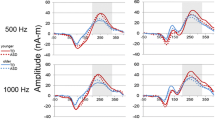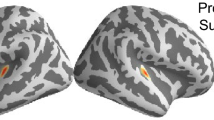Abstract
Previous studies have observed evoked response latency as well as gamma band superior temporal gyrus (STG) auditory abnormalities in individuals with autism spectrum disorders (ASD). A limitation of these studies is that associations between these two abnormalities, as well as the full extent of oscillatory phenomena in ASD in terms of frequency and time, have not been examined. Subjects were presented pure tones at 200, 300, 500, and 1,000 Hz while magnetoencephalography assessed activity in STG auditory areas in a sample of 105 children with ASD and 36 typically developing controls (TD). Findings revealed a profile such that auditory STG processes in ASD were characterized by pre-stimulus abnormalities across multiple frequencies, then early high-frequency abnormalities followed by low-frequency abnormalities. Increased pre-stimulus activity was a ‘core’ abnormality, with pre-stimulus activity predicting post-stimulus neural abnormalities, group membership, and clinical symptoms (CELF-4 Core Language Index). Deficits in synaptic integration in the auditory cortex are associated with oscillatory abnormalities in ASD as well as patient symptoms. Increased pre-stimulus activity in ASD likely demonstrates a fundamental signal-to-noise deficit in individuals with ASD, with elevations in oscillatory activity suggesting an inability to maintain an appropriate ‘neural tone’ and an inability to rapidly return to a resting state prior to the next stimulus.




Similar content being viewed by others
Notes
Complex demodulation uses a finite impulse response (FIR) low-pass filter with a Gaussian wave shape in the time domain. Complex demodulation is equivalent to a wavelet transformation using Morlet-type wavelets with a fixed time–frequency resolution across frequencies.
References
Belforte, J. E., Zsiros, V., Sklar, E. R., Jiang, Z., Yu, G., Li, Y., et al. (2010). Postnatal NMDA receptor ablation in corticolimbic interneurons confers schizophrenia-like phenotypes. Nature Neuroscience, 13(1), 76–83. doi:10.1038/nn.2447.
Berg, P., & Scherg, M. (1994). A multiple source approach to the correction of eye artifacts. Electroencephalography and Clinical Neurophysiology, 90(3), 229–241.
Bibbig, A., Traub, R. D., & Whittington, M. A. (2002). Long-range synchronization of gamma and beta oscillations and the plasticity of excitatory and inhibitory synapses: A network model. Journal of Neurophysiology, 88(4), 1634–1654.
Canolty, R. T., & Knight, R. T. (2010). The functional role of cross-frequency coupling. Trends in cognitive sciences, 14(11), 506–515.
Cantor, D. S., Thatcher, R. W., Hrybyk, M., & Kaye, H. (1986). Computerized EEG analyses of autistic children. Journal of Autism and Developmental Disorders, 16(2), 169–187.
Cardin, J. A., Carlen, M., Meletis, K., Knoblich, U., Zhang, F., Deisseroth, K., et al. (2009). Driving fast-spiking cells induces gamma rhythm and controls sensory responses. Nature, 459(7247), 663–667. doi:10.1038/nature08002.
Casanova, M. F., Buxhoeveden, D. P., & Brown, C. (2002). Clinical and macroscopic correlates of minicolumnar pathology in autism. Journal of Child Neurology, 17(9), 692–695.
Cornew, L., Roberts, T. P., Blaskey, L., & Edgar, J. C. (2012). Resting-state oscillatory activity in autism spectrum disorders. Journal of Autism and Developmental Disorders, 42(9), 1884–1894. doi:10.1007/s10803-011-1431-6.
Ehrlichman, R. S., Gandal, M. J., Maxwell, C. R., Lazarewicz, M. T., Finkel, L. H., Contreras, D., et al. (2009). N-methyl-d-aspartic acid receptor antagonist-induced frequency oscillations in mice recreate pattern of electrophysiological deficits in schizophrenia. Neuroscience, 158(2), 705–712.
Fatemi, S. H., Reutiman, T. J., Folsom, T. D., & Thuras, P. D. (2009). GABA(A) receptor downregulation in brains of subjects with autism. Journal of Autism and Developmental Disorders, 39(2), 223–230. doi:10.1007/s10803-008-0646-7.
Gage, N. M., Siegel, B., Callen, M., & Roberts, T. P. (2003). Cortical sound processing in children with autism disorder: An MEG investigation. Neuroreport, 14(16), 2047–2051.
Hakami, T., Jones, N. C., Tolmacheva, E. A., Gaudias, J., Chaumont, J., Salzberg, M., et al. (2009). NMDA receptor hypofunction leads to generalized and persistent aberrant gamma oscillations independent of hyperlocomotion and the state of consciousness. PLoS ONE, 4(8), e6755. doi:10.1371/journal.pone.0006755.
Hoechstetter, K., Bornfleth, H., Weckesser, D., Ille, N., Berg, P., & Scherg, M. (2004). BESA source coherence: A new method to study cortical oscillatory coupling. Brain Topography, 16(4), 233–238.
Jackson, M. E., Homayoun, H., & Moghaddam, B. (2004). NMDA receptor hypofunction produces concomitant firing rate potentiation and burst activity reduction in the prefrontal cortex. Proceedings of the National Academy of Sciences of the United States of America, 101(22), 8467–8472.
Lachaux, J. P., Rodriguez, E., Martinerie, J., & Varela, F. J. (1999). Measuring phase synchrony in brain signals. Human Brain Mapping, 8(4), 194–208.
Lakatos, P., Szilagyi, N., Pincze, Z., Rajkai, C., Ulbert, I., & Karmos, G. (2004). Attention and arousal related modulation of spontaneous gamma-activity in the auditory cortex of the cat. Brain Research. Cognitive Brain Research, 19(1), 1–9. doi:10.1016/j.cogbrainres.2003.10.023.
Lazarewicz, M. T., Ehrlichman, R. S., Maxwell, C. R., Gandal, M. J., Finkel, L. H., & Siegel, S. J. (2010). Ketamine modulates theta and gamma oscillations. Journal of Cognitive Neuroscience, 22(7), 1452–1464. doi:10.1162/jocn.2009.21305.
Leung, L. W. (1985). Spectral analysis of hippocampal EEG in the freely moving rat: Effects of centrally active drugs and relations to evoked potentials. Electroencephalography and Clinical Neurophysiology, 60(1), 65–77.
Lins, O. G., Picton, T. W., Berg, P., & Scherg, M. (1993). Ocular artifacts in recording EEGs and event-related potentials. II: Source dipoles and source components. Brain Topography, 6(1), 65–78.
Ma, J., & Leung, L. S. (2000). Relation between hippocampal gamma waves and behavioral disturbances induced by phencyclidine and methamphetamine. Behavioural Brain Research, 111(1–2), 1–11.
Ma, J., & Leung, L. S. (2007). The supramammillo-septal-hippocampal pathway mediates sensorimotor gating impairment and hyperlocomotion induced by MK-801 and ketamine in rats. Psychopharmacology (Berl), 191(4), 961–974.
Murias, M., Webb, S. J., Greenson, J., & Dawson, G. (2007). Resting state cortical connectivity reflected in EEG coherence in individuals with autism. Biological Psychiatry, 62(3), 270–273. doi:10.1016/j.biopsych.2006.11.012.
Oram Cardy, J. E. (2008). Auditory evoked fields predict language ability and impairment in children. International Journal of Psychophysiology, 68(2), 170–175.
Orekhova, E. V., Stroganova, T. A., Nygren, G., Tsetlin, M. M., Posikera, I. N., Gillberg, C., et al. (2007). Excess of high frequency electroencephalogram oscillations in boys with autism. Biological Psychiatry, 62(9), 1022–1029.
Paetau, R., Ahonen, A., Salonen, O., & Sams, M. (1995). Auditory evoked magnetic fields to tones and pseudowords in healthy children and adults. Journal of Clinical Neurophysiology, 12(2), 177–185.
Papp, N., & Ktonas, P. (1977). Critical evaluation of complex demodulation techniques for the quantification of bioelectrical activity. Biomedical Sciences Instrumentation, 13, 135–145.
Pinault, D. (2008). N-methyl d-aspartate receptor antagonists ketamine and MK-801 induce wake-related aberrant gamma oscillations in the rat neocortex. Biological Psychiatry, 63(8), 730–735.
Roberts, T. P., Cannon, K. M., Tavabi, K., Blaskey, L., Khan, S. Y., Monroe, J. F., et al. (2011). Auditory magnetic mismatch field latency: A biomarker for language impairment in Autism. Biological Psychiatry, 70(3), 263–269. doi:10.1016/j.biopsych.2011.01.015.
Roberts, T. P., Khan, S. Y., Blaskey, L., Dell, J., Levy, S. E., Zarnow, D. M., et al. (2009). Developmental correlation of diffusion anisotropy with auditory-evoked response. Neuroreport, 20(18), 1586–1591. doi:10.1097/WNR.0b013e3283306854.
Roberts, T. P., Khan, S. Y., Rey, M., Monroe, J. F., Cannon, K., Blaskey, L., et al. (2010). MEG detection of delayed auditory evoked responses in autism spectrum disorders: Towards an imaging biomarker for autism. Autism Research, 3(1), 8–18. doi:10.1002/aur.111.
Roberts, T. P., Schmidt, G. L., Egeth, M., Blaskey, L., Rey, M. M., Edgar, J. C., et al. (2008). Electrophysiological signatures: Magnetoencephalographic studies of the neural correlates of language impairment in autism spectrum disorders. International Journal of Psychophysiology, 68(2), 149–160.
Rojas, D. C., Maharajh, K., Teale, P., & Rogers, S. J. (2008). Reduced neural synchronization of gamma-band MEG oscillations in first-degree relatives of children with autism. BMC Psychiatry, 8, 66.
Rubenstein, J. L., & Merzenich, M. M. (2003). Model of autism: Increased ratio of excitation/inhibition in key neural systems. Genes Brain Behavior, 2(5), 255–267.
Santana, N., Troyano-Rodriguez, E., Mengod, G., Celada, P., & Artigas, F. (2011). Activation of thalamocortical networks by the N-methyl-D-aspartate receptor antagonist phencyclidine: reversal by clozapine. Biological Psychiatry, 69(10), 918–927. doi:10.1016/j.biopsych.2010.10.030.
Saunders, J. A., Gandal, M. J., Roberts, T. P., & Siegel, S. J. (2012). NMDA antagonist MK801 recreates auditory electrophysiology disruption present in autism and other neurodevelopmental disorders. Behavioural Brain Research, 234(2), 233–237.
Saunders, J. A., Tatard-Leitman V. M., Suh, J., Billingslea, E. N., Roberts, T. P., & Siegel, S. J. (2013). Knockout of NMDA receptors in parvalbumin interneurons recreates autism-like phenotypes. Autism Research, 6(2), 69–77. doi:10.1002/aur.1264.
Scherg, M., (1990). Fundamentals of dipole source potential analysis, in Auditory evoked magnetic fields and electric potentials. Advances in audiology.In: M.H.G.L.R. Gandori, (eds), Karger: Basel, Switzerland p. 40–69.
Scherg, M., & Berg, P. (1996). New concepts of brain source imaging and localization. Electroencephalography and Clinical Neurophysiology. Supplement, 46, 127–137.
Scherg, M., & Ebersole, J. S. (1994). Brain source imaging of focal and multifocal epileptiform EEG activity. Neurophysiologie Clinique, 24(1), 51–60.
Scherg, M., Ille, N., Bornfleth, H., & Berg, P. (2002). Advanced tools for digital EEG review: Virtual source montages, whole-head mapping, correlation, and phase analysis. Journal of Clinical Neurophysiology, 19(2), 91–112.
Scherg, M., & von Cramon, D. (1985). A new interpretation of the generators of BAEP waves I-V: Results of a spatio-temporal dipole model. Electroencephalography and Clinical Neurophysiology, 62(4), 290–299.
Sohal, V. S., Zhang, F., Yizhar, O., & Deisseroth, K. (2009). Parvalbumin neurons and gamma rhythms enhance cortical circuit performance. Nature, 459(7247), 698–702. doi:10.1038/nature07991.
Tamas, G., Buhl, E. H., Lorincz, A., & Somogyi, P. (2000). Proximally targeted GABAergic synapses and gap junctions synchronize cortical interneurons. Nature Neuroscience, 3(4), 366–371. doi:10.1038/73936.
Uhlhaas, P. J., & Singer, W. (2007). What do disturbances in neural synchrony tell us about autism? Biological Psychiatry, 62(3), 190–191.
Wechsler, D. (2003). Wechsler intelligence scale for children (Vol. 3). San Antonio, TX: The Psychological Corporation.
Whittington, M. A., Traub, R. D., & Jefferys, J. G. (1995). Synchronized oscillations in interneuron networks driven by metabotropic glutamate receptor activation. Nature, 373(6515), 612–615.
Whittington, M. A., Traub, R. D., Kopell, N., Ermentrout, B., & Buhl, E. H. (2000). Inhibition-based rhythms: Experimental and mathematical observations on network dynamics. International Journal of Psychophysiology, 38(3), 315–336.
Wilson, T. W., Rojas, D. C., Reite, M. L., Teale, P. D., & Rogers, S. J. (2007). Children and adolescents with autism exhibit reduced MEG steady-state gamma responses. Biological Psychiatry, 62(3), 192–197.
Zvyagintsev, M., Thonnessen, H., Dammers, J., Boers, F., & Mathiak, K. (2008). An automatic procedure for the analysis of electric and magnetic mismatch negativity based on anatomical brain mapping. Journal of Neuroscience Methods, 168(2), 325–333.
Acknowledgments
This study was supported in part by NIH grant R01DC008871 (TR), NIH grant R01DC008871-02S1, a NIH grant K08 MH085100 (JCE), Award number P30HD026979 from the Eunice Kennedy Shriver National Institute of Child Health & Human Development of the NIH, and grants from the Nancy Lurie Marks Family Foundation (NLMFF) and Autism Speaks. This research has been funded (in part) by a grant from the Pennsylvania Department of Health. The Pennsylvania Department of Health specifically disclaims responsibility for any analyses, interpretations or conclusions. Dr. Roberts gratefully acknowledges the Oberkircher Family for the Oberkircher Family Chair in Pediatric Radiology at CHOP.
Conflict of interest
No author declares a conflict of interest.
Author information
Authors and Affiliations
Corresponding author
Electronic supplementary material
Below is the link to the electronic supplementary material.
Rights and permissions
About this article
Cite this article
Edgar, J.C., Khan, S.Y., Blaskey, L. et al. Neuromagnetic Oscillations Predict Evoked-Response Latency Delays and Core Language Deficits in Autism Spectrum Disorders. J Autism Dev Disord 45, 395–405 (2015). https://doi.org/10.1007/s10803-013-1904-x
Published:
Issue Date:
DOI: https://doi.org/10.1007/s10803-013-1904-x




